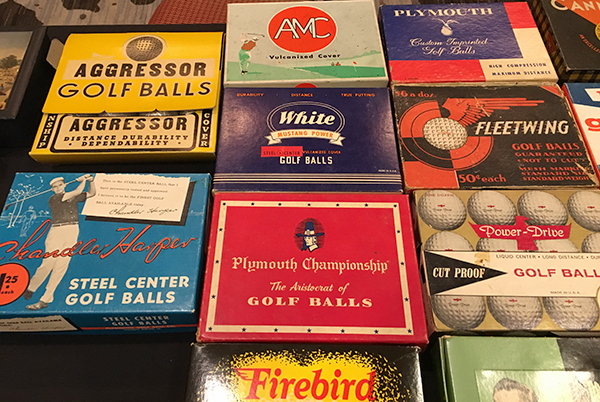This is one of the most basic of golf collecting categories along with golf clubs, autographs, and books. Balls are integral to the game, after all, and have a long history from the first wooden balls known from the Netherlands to the latest game improvement wonders from modern manufacturers. You name it and golf ball makers have tried it in an effort to make the game easier or just sell more balls.
Common categories include:
Ancient Artifacts
Featheries
Gutta Percha
Early 20th Century
Modern
Autographed
Logos
Specific Tournament
Game-used
Historic
The golf ball has come through at least three major evolutionary periods. In its earliest days as part of “kolf” in the Netherlands, the ball was a wooden spheroid, not quite round. Examples of these can still be found and can be expensive. There was also a leather pouch variety stuffed with hair. Examples of these are incredibly rare. More common are what is known as featheries.
In the early days of the game in Scotland, the leather pouch was stuffed with brine-soaked feathers and sewn shut. The unit hardened rather significantly after the feathers dried out and the ball was useful until it became a sodden in inclement weather or finally succumbed to repeated use. These were difficult to make at best and were the most expensive part of playing early golf in the late 1700s and the first half of the 1800s. Many examples exist from early makers and are often stamped with the maker’s name, as well as a numerical number signifying weight or size. As with anything else, condition is everything. Fine examples with clear stampings from desirable makers fetch top dollar. Poor quality balls, or those without markings can be found for many thousands less, sometimes at auction or from internet sales sites for less than $1000.

Around 1848, balls began to be made of gutta percha, a packing material made from the sap of a Malaysian tree. The early balls were completely smooth and flew erratically. As they suffered from wear and tear, the balls began to fly with more control. Golfers discovered these gashes and other surface injuries made the balls fly straighter, so later gutta percha balls were intentionally “patterned,” either with a hammer or, later, with molds specifically made to create surface patterns on the soft surface of the newly made gutta percha balls. Over time, ball makers got creative with the patterns and such balls have become highly collectible with some patterns fetching many thousands of dollars. Early hand-hand hammered “gutties” are also desirable collectibles with, again, condition and markings being deciding factors in value.

As golf balls continued to improve throughout the 20th century, new collectible niches arose. These include balls autographed by players, the more famous, the more desirable the ball; balls certified to have been used by historic players during a tournament, the more historic the player or tournament, the better; balls of historic patent, or that were “game changers” of some kind; balls with specific logos such as specific golf clubs, tournaments, even colleges or specific players.
Early golf ball boxes, usually from the early to mid-20th century, are collectible for their unique styles, illustrations, and graphic and colorful designs. Balls from this period, too, had many dozens of unique and colorful names that have become collectible in their own right – such as Bogey, Zodiac, Vardon Flyer, Eclipse, Eureka, and Faroid.

Look for balls on internet auction sites, at flea markets, antique trade shows, golf collector trade shows and from known buyers and sellers (collectors) of golf balls. Be sure to do your homework before plunking down hard-earned money for any golf ball. Email the gentlemen below for advice, or try Pete Georgiady, executive director of the GHS, for names of known golf ball collectors.
Books that will help the beginning golf ball collector:
500 Years of Golf Balls, History and Collectors Guide
John F. Hotchkiss, Antique Trader Books, 1997
284 pages, 11-by-8.5
(Found on Amazon for from $4 to $40)
The Essential Guide to Collecting Golf Balls
Colin Palmer, privately published, 2010
141 pages, 11-by-8.5
Limited availability (Check with www.Fine golfbooks.com)
